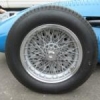There were cheap rear engine rear wheel drive small cars in 60s but they were replaced with front wheel drive front engine cars. Why? I'm not a car engineer but I would think that a rear engine with rear wheel drive is simpler technology and thus cheaper to make than a front wheel drive car where you have to get the power to the turning wheels. And still there were only FF or FR cars in 70s with only one or two remnants from the 60s hanging on RR. What makes front engine so superior over rear engine?
Why did front engine won so easily over rear engine in small cars?
#1

Posted 09 February 2024 - 18:38
Advertisement
#2

Posted 09 February 2024 - 20:20
I think there are many reasons, I can think about some:
- weight distribution (this impacts handling, and also general layout of the car). in order to mitigate it you have to have a rather short car - that comes with less space (and cargo space) in general
- the only cost advantage is in RWD configuration if you have AWD or FWD you're back where you started.
rear engine made sense for very small cars initially - as people wanted more out of tiny cars - they did not make sense anymore.
They still exist in areas where cargo space is not an issue ![]()
#3

Posted 09 February 2024 - 21:54
FR needs a longer car than RR or FF. FF is better than RR because (a) crash, you decelerate the engine as hard as you like and reserve more of your crumple space for the passengers , whereas with RR the passengers are the meat in the sandwich(b) limit handling, RR tends towards oversteer, FF tends towards understeer. © your rear axle design becomes much simpler with FF than with either of the other 2.
I'm sure there are other reasons
#4

Posted 11 February 2024 - 22:17
If I look back then most mid-engine chassis were not particularly stiff, certainly not comparable to the stamped steel monocoques of Cortina's and later Golf's. I think the MR2 was the first solid chassis?
I also have it, perhaps incorrectly, in my head a transverse drivetrain sits higher than a longitudinal one, and if that is correct most small mid-engine cars used transverse mounted drivetrains.
#5

Posted 12 February 2024 - 21:07
FR needs a longer car than RR or FF. FF is better than RR because (a) crash, you decelerate the engine as hard as you like and reserve more of your crumple space for the passengers , whereas with RR the passengers are the meat in the sandwich(b) limit handling, RR tends towards oversteer, FF tends towards understeer. © your rear axle design becomes much simpler with FF than with either of the other 2.
I'm sure there are other reasons
Interestingly these rules are changing with the advent of EVs. The motor is much lighter and more compact while the battery is the big mass but more vulnerable in a crash than a combustion engine. Obvious consequence is that many 2WD EVs are going for RWD.
#6

Posted 13 February 2024 - 06:11
Good point i'd forgotten about production BEVs, never having worked on one from the word go. Hmm, so that's a good question why are cheap BEVs RWD? Just to avoid having a pointy hard impactor (the motor transaxle) in front of the battery?
#7

Posted 13 February 2024 - 13:32
I think there are many reasons, I can think about some:
- weight distribution (this impacts handling, and also general layout of the car). in order to mitigate it you have to have a rather short car - that comes with less space (and cargo space) in general
- the only cost advantage is in RWD configuration if you have AWD or FWD you're back where you started.
rear engine made sense for very small cars initially - as people wanted more out of tiny cars - they did not make sense anymore.
They still exist in areas where cargo space is not an issue
Handling is the key element here. An understeering car is far safer for Mr Average than an oversteering one. As demonstrated by the number of Renault Dauphines seen upside down in ditches back in the day. Whereas you could do anything you liked with a Mini and it would forgive you.
Edited by Sterzo, 13 February 2024 - 13:34.
#8

Posted 15 February 2024 - 13:19
Could be a factor. Also it could be you have so much instant torque - not a great idea for a fwd car. The drive-shafts (have no idea how the front ones are called in english) are also harder to make with so much instant torque.Good point i'd forgotten about production BEVs, never having worked on one from the word go. Hmm, so that's a good question why are cheap BEVs RWD? Just to avoid having a pointy hard impactor (the motor transaxle) in front of the battery?
#9

Posted 15 February 2024 - 14:37
I wonder when the old 'big bang' theory of MotoGP comes into hi-po EV land. If instant torque is a problem, modulate it with software?
#10

Posted 15 February 2024 - 21:05
In English, half shafts, but drive shafts isn't unheard of, which then gets confused with prop (propeller) shaft.
#11

Posted 15 February 2024 - 22:21
RWD has lots of advantages.
- FWD generally requires front biased weight distribution with all the downsides - understeer, poor launch traction, tyre wear
- no torque steer
EVs are an opportunity to implement RWD without the downsides associated with Front or Rear ICE placement.
One EV maker (don't remember which) claims better energy efficiency for RWD.
#12

Posted 16 February 2024 - 04:58
Understeer is not a downside, at least in the vehicle dynamics world. I've spent much of the last 22 years trying to find more understeer. Bronco was the first program where I hit the initial target, despite the usual loss of understeer as the program progresses!
Edited by Greg Locock, 16 February 2024 - 04:59.
#13

Posted 16 February 2024 - 15:17
FWD has horrible traction when initially accelerating from a stop. My Jetta can break the fronts loose and invoke the TC on a damp road all too easily, and it's a pretty seriously underpowered car.
#14

Posted 16 February 2024 - 15:39
your rear axle design becomes much simpler with FF than with either of the other 2.
I would think that FF front axle is more difficult to make than rear axle of RR, keeping total cost of both axles cheaper in RR.
I can believe that they weren't as fixated on minimizing the costs in 60s and 70s as today and thus handling could be more important factor in designing process.
#15

Posted 17 February 2024 - 16:28
Handling is the key element here. An understeering car is far safer for Mr Average than an oversteering one. As demonstrated by the number of Renault Dauphines seen upside down in ditches back in the day. Whereas you could do anything you liked with a Mini and it would forgive you.
Ask a great number of Renault LeCar/R5 SCCA racers about "forgiving" front wheel driver cars.
#16

Posted 17 February 2024 - 19:01
When Lotus made the Lotus FWD Sunbeam, ie drop a 150 hp engine into a boring hatchback. Motoring journalists would pick one up at Hethel, drop the clutch, get to the second bend in the road and into the ditch. Mind you one of our mechanics splashed out on a nifty Peugeot 205 and ended up in the same ditch.
















